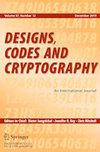A generalized construction of variable-length non-overlapping codes
IF 1.2
2区 数学
Q3 COMPUTER SCIENCE, THEORY & METHODS
引用次数: 0
Abstract
Non-overlapping codes over a given alphabet are defined as a set of words satisfying the property that no prefix of any length of any word is a suffix of any word in the set, including itself. When the word lengths are variable, it is additionally required that no word is contained as a subword within any other word. In this paper, we present a new construction of variable-length non-overlapping codes that generalizes the construction by Bilotta. Subsequently, we derive the generating function and an enumerative formula for our constructed code, and establish upper bound on their cardinalities. A comparison with the bound provided by Bilotta shows that the newly constructed code offers improved performance in the code size.
变长非重叠码的一种广义构造
给定字母表上的非重叠编码被定义为满足以下属性的词集:任何词的任何长度的前缀都不是词集中任何词(包括其本身)的后缀。当单词长度可变时,还要求任何单词都不能作为子单词包含在任何其他单词中。在本文中,我们提出了一种新的可变长度非重叠编码结构,它对比洛塔的结构进行了概括。随后,我们推导出了所构建代码的生成函数和枚举公式,并确定了它们的心数上限。与比洛塔提供的界限进行比较后发现,新构建的代码在代码大小方面性能更佳。
本文章由计算机程序翻译,如有差异,请以英文原文为准。
求助全文
约1分钟内获得全文
求助全文
来源期刊

Designs, Codes and Cryptography
工程技术-计算机:理论方法
CiteScore
2.80
自引率
12.50%
发文量
157
审稿时长
16.5 months
期刊介绍:
Designs, Codes and Cryptography is an archival peer-reviewed technical journal publishing original research papers in the designated areas. There is a great deal of activity in design theory, coding theory and cryptography, including a substantial amount of research which brings together more than one of the subjects. While many journals exist for each of the individual areas, few encourage the interaction of the disciplines.
The journal was founded to meet the needs of mathematicians, engineers and computer scientists working in these areas, whose interests extend beyond the bounds of any one of the individual disciplines. The journal provides a forum for high quality research in its three areas, with papers touching more than one of the areas especially welcome.
The journal also considers high quality submissions in the closely related areas of finite fields and finite geometries, which provide important tools for both the construction and the actual application of designs, codes and cryptographic systems. In particular, it includes (mostly theoretical) papers on computational aspects of finite fields. It also considers topics in sequence design, which frequently admit equivalent formulations in the journal’s main areas.
Designs, Codes and Cryptography is mathematically oriented, emphasizing the algebraic and geometric aspects of the areas it covers. The journal considers high quality papers of both a theoretical and a practical nature, provided they contain a substantial amount of mathematics.
 求助内容:
求助内容: 应助结果提醒方式:
应助结果提醒方式:


